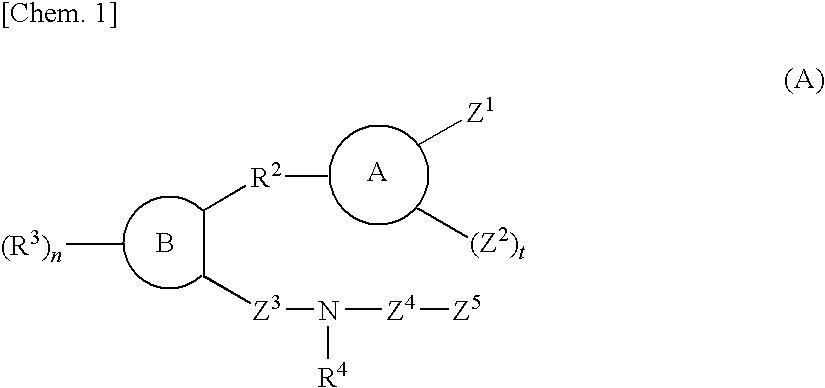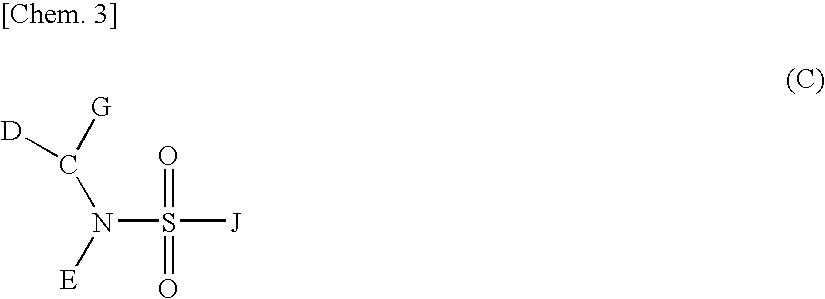Sulfonamide compound or salt thereof
a technology of sulfonamide and compound, which is applied in the direction of ester active ingredients, amide active ingredients, drug compositions, etc., can solve the problems of patients showing no improvement with anticholinergic agents, difficult use of anticholinergic agents, and risk of urinary retention, so as to achieve potent ep1 receptor antagonistic activity and lower urinary tra
- Summary
- Abstract
- Description
- Claims
- Application Information
AI Technical Summary
Benefits of technology
Problems solved by technology
Method used
Image
Examples
examples and examples
PREPARATIVE EXAMPLES AND EXAMPLES
[0304]Hereinbelow, the methods for preparing the compound of the present invention will be described in more detail with reference to Preparative Examples and Examples of the compound of the present invention, but the present invention is not limited to these Preparative Examples and Examples. Furthermore, the methods for preparing the starting material compounds for the compound of the present invention will be described in Reference Examples.
[0305]In this regard, the symbols in Reference Examples, Preparative Examples, and Examples have the following meanings (the same shall apply hereinafter.).
[0306]Rf: Reference Example No., Pre: Preparative Example No., Ex: Example No., Str: structural formula, Syn: production process (the numeral shows that it was produced using a corresponding starting material, similar to the case of an Example compound having its number as the Example No. In a case where R is attached before the number, the numeral shows tha...
reference example 1
[0307]18.7 g of 3-chloro-2-methylaniline was dissolved in 120 mL of pyridine, and 22.9 g of p-toluene sulfonylchloride was added portionwise thereto over 30 minutes, followed by stirring at room temperature overnight. The reaction liquid was concentrated under reduced pressure, and to the obtained residue was added water, followed by extraction with ethyl acetate. The organic layer was washed with 1 M hydrochloric acid, saturated brine, an aqueous saturated sodium hydrogen carbonate solution, and saturated brine, and then dried over anhydrous sodium sulfate. The solvent was evaporated under reduced pressure to obtain 34.6 g of N-(3-chloro-2-methylphenyl)-4-methylbenzenesulfonamide.
reference example 2
[0308]34.5 g of N-(3-chloro-2-methylphenyl)-4-methylbenzenesulfonamide was dissolved in 232 mL of DMF, and 21.4 g of ethyl bromoacetate and 19.3 g of potassium carbonate were added thereto, followed by stirring at 100° C. for 1 hour. The reaction liquid was cooled to room temperature, and then water was added, followed by extraction with ethyl acetate. The organic layer was washed with brine, and then dried over anhydrous sodium sulfate. The solvent was evaporated under reduced pressure, and the obtained residue was purified by silica gel column chromatography (hexane:ethyl acetate=80:20) to obtain 34.6 g of ethyl N-(3-chloro-2-methylphenyl)-N-[(4-methylphenyl)sulfonyl]glycine.
PUM
| Property | Measurement | Unit |
|---|---|---|
| temperature | aaaaa | aaaaa |
| temperature | aaaaa | aaaaa |
| temperature | aaaaa | aaaaa |
Abstract
Description
Claims
Application Information
 Login to View More
Login to View More - R&D
- Intellectual Property
- Life Sciences
- Materials
- Tech Scout
- Unparalleled Data Quality
- Higher Quality Content
- 60% Fewer Hallucinations
Browse by: Latest US Patents, China's latest patents, Technical Efficacy Thesaurus, Application Domain, Technology Topic, Popular Technical Reports.
© 2025 PatSnap. All rights reserved.Legal|Privacy policy|Modern Slavery Act Transparency Statement|Sitemap|About US| Contact US: help@patsnap.com



